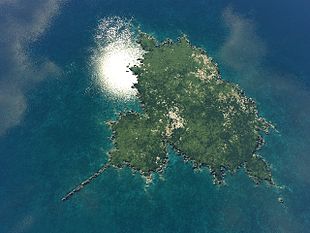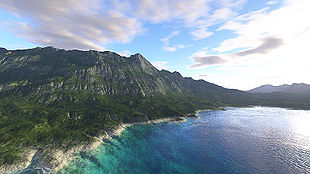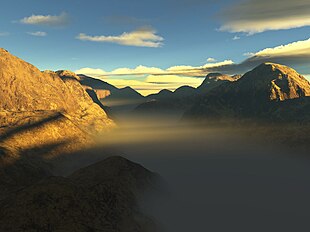Terragen
| Terragen | |
|---|---|
| Basic data
|
|
| Maintainer | Matt Fairclough |
| developer | Planetside software |
| Publishing year | 2001 |
| Current version | 4th |
| operating system |
Microsoft Windows from XP
Mac OS X from 10.6 |
| programming language | C ++ |
| category | Landscape generator |
| License | proprietary , freeware |
| German speaking | No |
| https://planetside.co.uk/free-downloads/terracht-4-free-download/ | |

Terragen is a 3D landscape generator developed by Matt Fairclough for creating photorealistic graphics. The current version Terragen 4 is available for Microsoft Windows and Apple Macintosh . It can be downloaded as a free version, but its resolution, level of detail and animation options are limited. There was also a variant called Terragen Classic , the sale of which was officially discontinued by the manufacturer.
Components of Terragen Classic
Terragen is essentially based on four components: Terrain, Surface, Sky / Atmosphere and Water.
terrain
Terragen uses heightmaps to describe the shape of the landscape . A height value is assigned to each point in the terrain. These heightmaps are usually simply called terrain . Terragen uses standard formats for terrains according to the formation regulations . Thus a 513² terrain contains 513 * 513 points and 512 * 512 areas in between. Although formats that do not correspond to this standard can be loaded without any problems, most terrains actually have the formats 513², 1025², 2049² etc. Terragen contains its own terrain generator, but there are numerous freeware generators programmed by users that sometimes deliver better results. The external terrain generators include B. World Machine, Terrabrush, Terraformer2, Leveller and Terrapainter.
Surface
The surface design is done in Terragen using the built-in surface system. The surface consists of different layers (so-called layers ). The distribution of the individual layers can by means of slope ( Slope ) and the height to be regulated. For example, it is possible to create a layer for grass, which, like real grass, only appears in the valleys of a mountain range and only in flat areas there. Both the distribution and the appearance of each layer can be regulated separately. When it comes to the design options for the color and structure of the surface in Terragen, numerous options that are otherwise only found in professional ray tracing programs have been integrated indirectly. Terragen does not have the option of including textures , bump maps or masks itself. In order to give large landscapes a more detailed structure, Terragen uses a procedural bump mapping, where height and structure can be adjusted.
Sky / atmosphere
The sky is rendered on a simple, curved surface . There is also a simple system for randomly creating clouds that can be chosen either as a two-dimensional texture layer or as a three-dimensional object. There is also the possibility of changing the atmosphere of the world so that, for example, glowing red sunsets or thick fog are possible.
water
The water surface is also created procedurally. With realistic reflections and transparency, the water in Terragen is one of the most elaborate and realistic features. In addition, waves of various types are simulated in the water , and foam can also be set near the coast .
Advantages and disadvantages of Terragen Classic
advantages
One of the biggest differences between Terragens and other raytracing programs is undoubtedly the strong specialization in landscape. This gives rise to the main advantages and disadvantages.
The first noticeable advantage is that the basics can be learned quickly. Although the program offers an exclusively English user interface, even a beginner can quickly get good results. Another advantage is the freeware version - competing products do not offer this service and are even more expensive than registering Terragen, even in the cheapest version.
Small films can also be rendered with scripts or external additional tools. Beautiful effects result from tracking shots through the landscape or sunrises and sunsets.
disadvantage
However, there are also significant disadvantages associated with all of this. More experienced users often complain about the slow development and constant postponements or non-compliance with deadlines . For example, the release date for TG2 was announced at the end of 2004, and on December 15, 2006 the technology preview release of TG 2 finally took place. Even the last update after about two years of downtime did not convince many long-term users. The extreme disadvantage and reason why some users have turned to more expensive programs is the lack of 3D objects within the landscape, such as B. real vegetation and stones. Although the surface system can simulate landscapes quite realistically from a great distance, nearby structures are often coarse and flat. In addition, the resolution of the terrain in the foreground often leaves a lot to be desired - visible corners and edges are the result. Terragen 2 wants to eliminate this shortcoming. Procedural terrains are intended to give the landscape the necessary detail when viewed from any distance. In addition, 3D objects such as trees and stones should be able to be distributed over the terrain. This means that Terragen would be able to catch up with Vue 5 infinite .
Terragen 2
TerraGen 2 (short: * TG2 *) is the next major version of Terragen. TG2 is not to be confused with Terragen D / TGD. TGD is just the name of the new rendering engine.
The preview version of Terragen2 could be officially downloaded on December 15th, 2006 and overloaded the servers. Although Terragen has not yet reached version 1.0, TG2 is still considered to be the second version of Terragen, as TG2 is programmed from scratch and has little in common with the old version. Terragen is expanded to include a long list of features:
- Clouds
- new cloud engine
- several layers of clouds
- terrain
- procedural terrains
- Overhangs
- Tunnels / caves
- New atmosphere engine
- 3D objects from other 3D programs can be inserted.
- Plants, trees
- Stones, rocks
- water
- several water levels
- revised water engine
- further developed rendering engine: TGD
Newer versions
On August 18, 2013, the manufacturer announced the release of Terragen 3.0.07.0; in February 2016 beta testers were wanted for Terragen 3.4.
commercial use
Terragen or parts of it are used again and again in commercials, video games or movies. Terragen was used to create the backgrounds of the game Serious Sam or Battlefield , for example , and a specially adapted version was used in a Dodge commercial in the USA .
In 2000 Terragens programmer, Matt Fairclough, worked at Digital Domain . The Terragen version that was created there was further developed under the name Engen independently of Terragen and was used in numerous films such as Stealth - Under the Radar or The Day After Tomorrow . The advert for the Motorola Pebl mobile phone, which was also broadcast in Germany, was also created in Engen. Although Engen and Terragen 2 are based on the same code and are naturally similar in many ways, they are now completely independent of each other. Nevertheless, it often happens that Terragen is mentioned, although Engen was used.
Web links
- Official website (English)
Individual evidence
- ↑ Terragen, the fourth. In: Digital Production. November 14, 2016, accessed September 7, 2018 .
- ↑ Terragen Classic. Planetside Software, accessed September 7, 2018 .
- ↑ TG 2 Technology Preview Download: http://www.planetside.co.uk/terracht/tg2/tg2tp/ . December 17, 2006.
- ↑ Announcements in the Planetside forum, http://www.planetside.co.uk/forums/index.php/topic,16643.0.html . Retrieved February 12, 2016.
- ↑ Buyers of Terragen 3 should receive an update to Terragen 4; see. http://terAGEN4.com/pre-order/ , accessed February 12, 2016.


